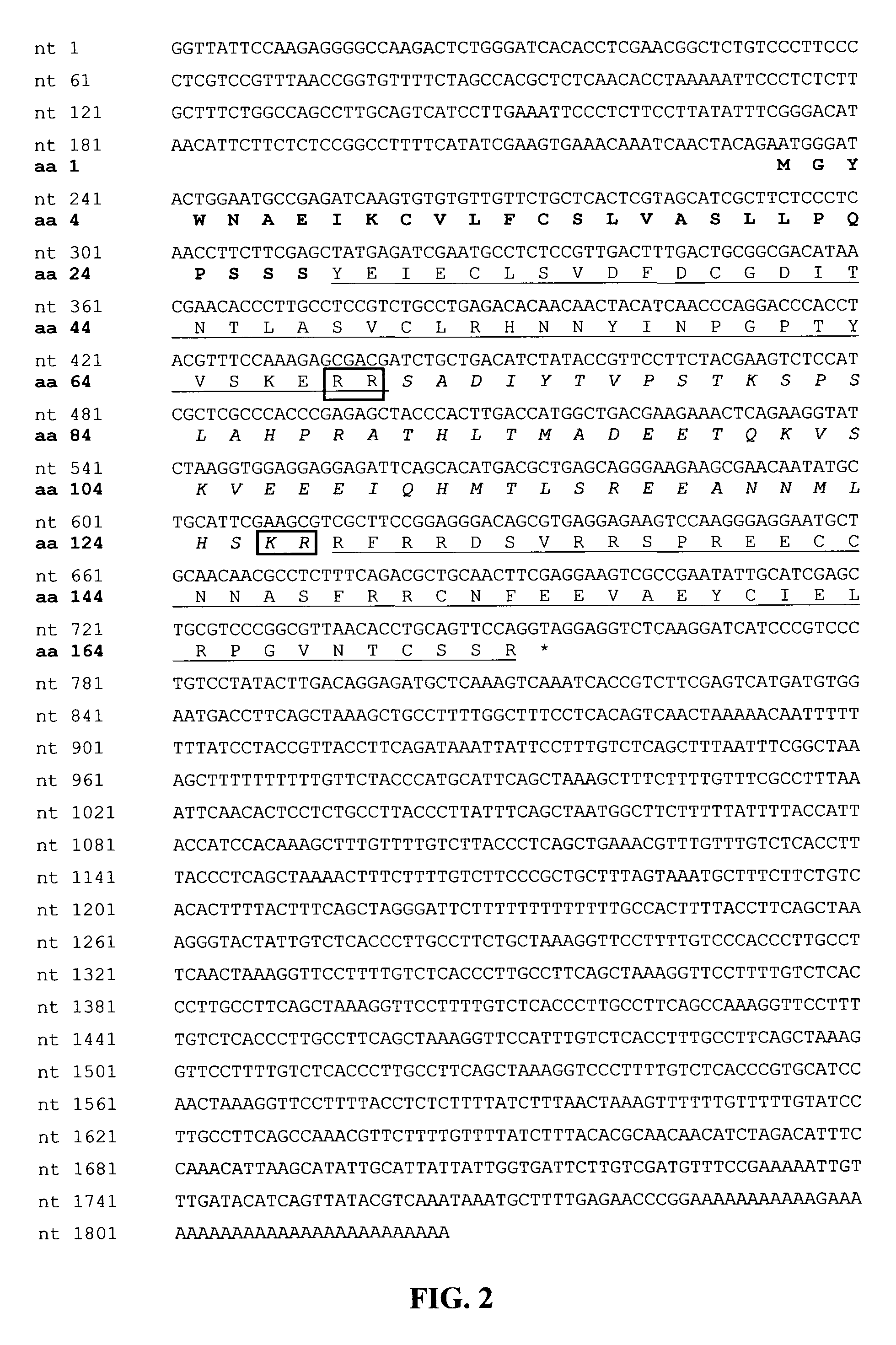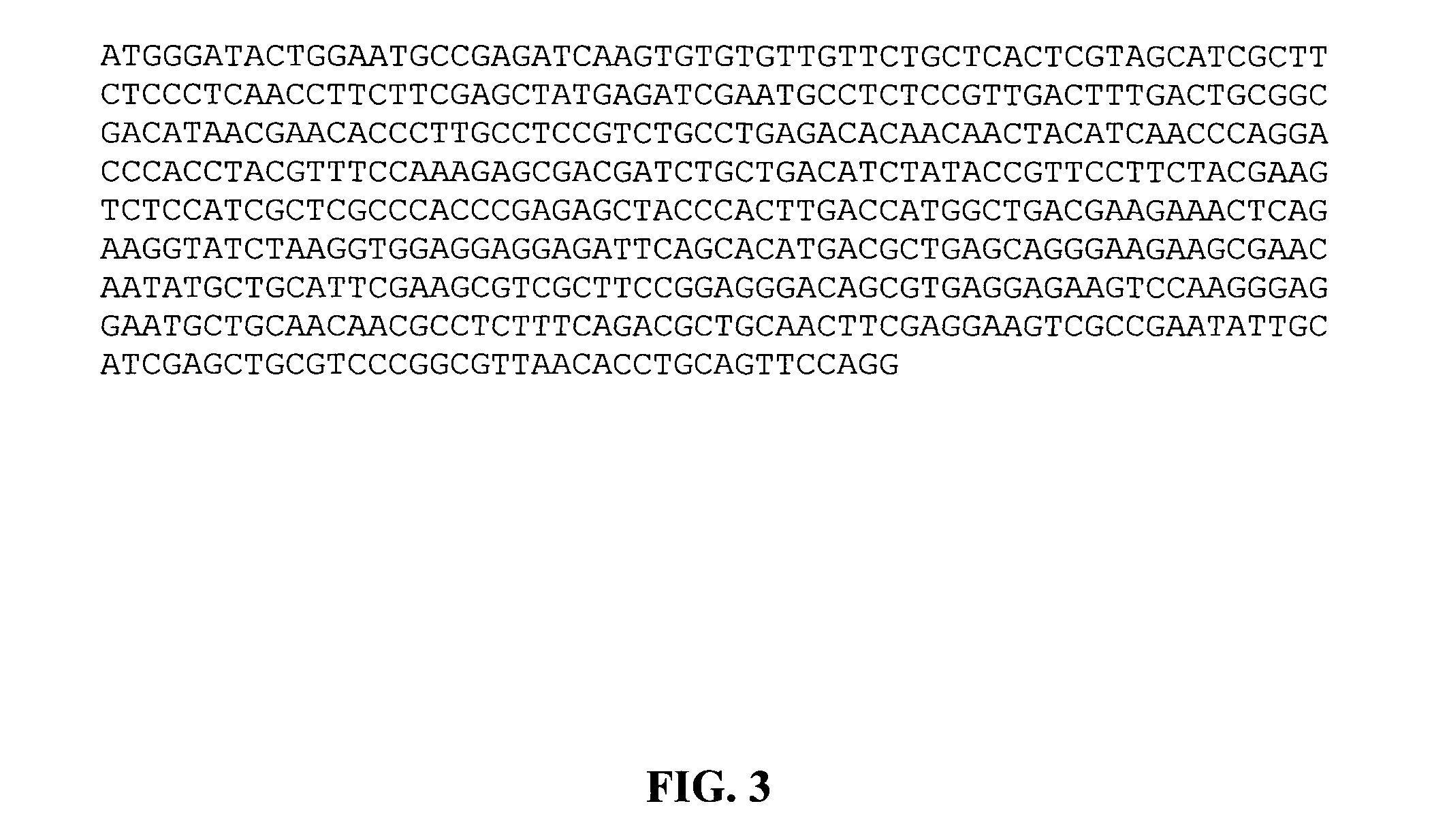Insulin-like gene of prawns and uses thereof
a technology of prawns and genes, applied in the field of prawns' insulin-like genes, can solve the problems of inefficient population, high technical skill, and tedious procedures, and achieve the effect of increasing the level of mr-iag polypeptides
- Summary
- Abstract
- Description
- Claims
- Application Information
AI Technical Summary
Benefits of technology
Problems solved by technology
Method used
Image
Examples
example 1
Identification of Mr-IAG Gene and Polypeptide
Animals
[0112]Mature M. rosenbergii males (18-80 g) were collected from a breeding population that was hatched and grown at the Ben-Gurion University. Their morphotypes were determined by cheliped shape, coloration, spination and size in relation to carapace length. Endocrine manipulation was employed by X organ-Sinus gland complex (XO-SG) removal through bilateral eye-stalk ablation, causing hypertrophy of the AG (hAG) as described previously for C. quadricarinatus and also for Macrobrachium nipponense. The procedure was performed on 15 blue claw males and on orange claw and small males. Juveniles, 110-120 days post-larvae (PL110-120) were sexed according to the presence of genital papillae and appendix masculinae.
Construction of a cDNA Library of the AG Using Suppression Subtractive Hybridization (SSH)
[0113]Total RNA isolation, cDNA preparation and subtraction library of the AG was done as described in Manor et al. (ibid.) using the cDNA...
example 2
Silencing of Mr-IAG Gene Expression by dsRNA
Double Stranded RNA Preparation
[0127]PCR products (94° C. for 3 min followed by 35 cycles of 94° C. for 30 seconds, 57° C. for 30 seconds and 72° C. for 1 minute, followed by 72° C. for 10 minutes) of plasmids containing GFP or Mr-IAG open reading frame, primed by two gene specific primers with T7 promoter site at the 5′ of one primer (T7P; 5′-TAATACGACTCACTATAGGG-3′ SEQ ID NO:20) were used as templates for RNA synthesis. Primer pairs used were as follows: for Mr-IAG sense RNA synthesis: primer T7 PF (5′-T7PATGGGATACTGGAA TGCCGAG-3′ SEQ ID NO:21) vs. primer R (5′-CTGGAACTGCAGGTGTTAACG-3′ SEQ ID NO:22). For Mr-IAG anti-sense RNA synthesis: primer F (5′-ATGGGATACTG GAATGCCGAG-3′ SEQ ID NO:23) vs. primer T7PR (5′-T7PCTGGAACTGCAGGTGT TAACG-3′ SEQ ID NO:24). For GFP sense RNA synthesis: primer T7 PF (5′-T7PATGG TGAGCAAGGGCGAG-3′ SEQ ID NO:25) vs. primer R (5′-TGTACAGCTCGTCCATG CC-3′ SEQ ID NO:26). For GFP anti-sense RNA synthesis: primer F (5′-...
PUM
| Property | Measurement | Unit |
|---|---|---|
| apparent molecular weight | aaaaa | aaaaa |
| apparent molecular weight | aaaaa | aaaaa |
| molecular weights | aaaaa | aaaaa |
Abstract
Description
Claims
Application Information
 Login to View More
Login to View More - R&D
- Intellectual Property
- Life Sciences
- Materials
- Tech Scout
- Unparalleled Data Quality
- Higher Quality Content
- 60% Fewer Hallucinations
Browse by: Latest US Patents, China's latest patents, Technical Efficacy Thesaurus, Application Domain, Technology Topic, Popular Technical Reports.
© 2025 PatSnap. All rights reserved.Legal|Privacy policy|Modern Slavery Act Transparency Statement|Sitemap|About US| Contact US: help@patsnap.com



